July 28, 2008
Mexican Peppers - Salmonella Saintpaul Outbreak
At Pinellas County Extension, the Family and Consumer Sciences Program Area wants you to be aware of all potential food hazards so that you can make knowledgeable decisions about the food you buy for your family. In an effort to keep you informed, we are releasing the following FDA tomato update. Please follow the FDA’s instructions so that you are not affected by this foodborne illness.
The U.S. Food and Drug Administration is updating its warning to consumers nationwide concerning the outbreak of Salmonella Saintpaul.
The FDA's advice to avoid raw jalapeno peppers, and foods that contain them, now applies only to peppers grown, harvested or packed in Mexico.
The U.S. Food and Drug Administration (FDA) is advising consumers that jalapeno and serrano peppers grown in the United States are not connected with the current Salmonella St. Paul outbreak and consumers may feel free to eat them without concern of contamination.
In addition to domestically grown raw jalapeno peppers, commercially canned, pickled and cooked jalapeno peppers from any and all geographic locations also are not connected with the current Salmonella Saintpaul outbreak.
FDA is working with state regulatory agencies and food industry groups representing restaurants, grocery stores, and wholesalers to ensure that this new advisory is clearly understood by everyone. The FDA will continue to refine its consumer guidance as the agency's investigation continues.
This new information is based on evidence gathered by the intensive investigation that has been ongoing for several weeks to find the source of the contamination which has led to the Salmonella Saintpaul outbreak. The current traceback investigation and harvesting dates, matched with the dates that people became ill, have combined to indicate that the contaminated peppers originated in Mexico.
Additional traceback information obtained this week indicates that the Agricola Zaragoza plant in McAllen, Texas - from where the positive jalapeno pepper sample was taken - have determined that the Texas plant was not the original source of the contamination.
FDA is continuing to advise that people in high risk populations, such as elderly persons, infants and people with impaired immune systems, avoid eating raw Serrano peppers from Mexico or food made from raw Serrano peppers from Mexico until further notice.
If you have any questions or concerns on this issue, please call us at 582-2100 and we will do our best to help you.
July 22, 2008
Solar Power in the Sunshine State
 Florida is called the “Sunshine State”. The sun bathes us with over 200 sunny days per year in the Tampa Bay area. Many people say they have heard that solar energy applications only work well in the clear skies of the desert southwest and won’t be as effective in Florida’s weather conditions. While it is true that the desert southwest has the largest solar resource in the continental U.S., this does not mean that Florida can’t provide substantial solar energy. Florida receives 85% of the maximum solar resource available in the U.S., making it ideal for using solar energy. The power of the sun is considerable - each hour, enough sunlight reaches the Earth to meet the world’s energy needs for a year.
Florida is called the “Sunshine State”. The sun bathes us with over 200 sunny days per year in the Tampa Bay area. Many people say they have heard that solar energy applications only work well in the clear skies of the desert southwest and won’t be as effective in Florida’s weather conditions. While it is true that the desert southwest has the largest solar resource in the continental U.S., this does not mean that Florida can’t provide substantial solar energy. Florida receives 85% of the maximum solar resource available in the U.S., making it ideal for using solar energy. The power of the sun is considerable - each hour, enough sunlight reaches the Earth to meet the world’s energy needs for a year.How much of that sunshine are we using to power our homes and businesses in Florida? Not much it turns out. Like most states in the South, Florida is heavily dependent on fossil fuels for energy; with 80% of its electrical generating capacity based on non-renewable sources. According to the U.S. Department of Energy, Florida gets 37% of its power from coal, 21% from natural gas, and 22% from petroleum. Clean, renewable sources (wind, geothermal, biomass, and solar) represent only about 3% of Florida's power generating capacity, and the rest (18%) comes from nuclear power plants. With the concerns about carbon dioxide emissions from fossil fuels and our dependence on foreign oil, the push for renewable energy sources has gained momentum.
Why has it taken so long to get renewable sources of energy like solar power into our everyday world? Photovoltaic (PV) systems, which convert sunlight directly to electricity, consume no fuel, use no water, and produce no waste. One of the big issues with solar power has been that it costs more than electricity generated by conventional means. Conventionally generated electricity ranges between 5 and 18 cents per kilowatt hour (the amount of money to get a kilowatt of power for an hour) but in most places it's below 10 cents, according to the Energy Information Agency. Solar energy costs around 15 to 17 cents a kilowatt hour. To install solar panels to power an average home with electricity could cost over $20,000. As the cost of conventional power resources increases and the technology improves for photovoltaic (PV) panels, solar energy will become more and more cost effective.
There are substantial federal income tax credits (30% of the cost of a solar hot water system) and State of Florida rebates ($500 for a system) for the installation of solar systems in Florida. In addition, one Florida utility, Progress Energy Florida (PEF), recently implemented a new program that offers additional utility incentives of $450 for the installation of solar water heating systems. For PV systems, there is a federal income tax credit of up to $2,000 plus a State of Florida rebate of up to $20,000 for home applications and up to $100,000 for commercial applications.
Additional information on these solar energy tax credits, state rebate and utility incentive programs can be found by clicking on the following links:
- Federal tax credits: http://www.fsec.ucf.edu/en/media/enews/2005/2005-03_EPAct2005.htm
- State of Florida tax rebates: http://www.fsec.ucf.edu/en/media/enews/2006/2006-04-R1_Energy-act.htm
- Progress Energy incentives: http://www.progress-energy.com/custservice/flares/save/solarheater.asp
This is an exciting time for solar energy. PV systems are being installed in unprecedented numbers in the United States and worldwide. The first new U.S. concentrating solar power plant in nearly 15 years was completed in 2005, and more plants are planned for the coming years. Solar energy is on the verge of becoming a viable part of our nation’s energy supply, but challenges must still be overcome before it is competitive with conventional energy sources.
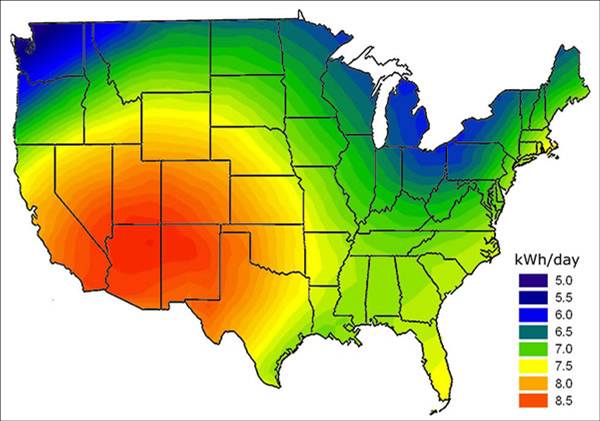
This image comes from a study from the Florida Solar Energy Center. The map clearly shows that the desert southwest has the largest solar resource in the continental U.S., but Florida is not very far behind with 85% of the maximum PV resource of any location in the country, making Florida a very cost-effective location for using solar energy. You can view the complete study at: www.fsec.ucf.edu/en/publications/html/FSEC-PF-380-04/.
Resources:
Florida Solar Energy Center http://www.fsec.ucf.edu/en/
Florida Dept of Environmental Protection http://www.dep.state.fl.us/energy/sources/solar.htm
Department of Energy http://www.nrel.gov/docs/fy06osti/39081.pdf
Florida’s Energy Act http://www.dep.state.fl.us/energy/energyact/default.htm
Solar Energy Incentives Program http://www.dep.state.fl.us/energy/energyact/solar.htm
July 21, 2008
FDA Lifts Warning About Eating Certain Types of Tomatoes – Certain Peppers Now Suspected
The U.S. Food and Drug Administration is updating its warning to consumers nationwide concerning the outbreak of Salmonella Saintpaul.
Cool Snacks for Summer
Wash a bowl of seedless grapes, blueberries, or strawberries and set in the freezer for about an hour. Poke colored toothpicks into the frozen fruit and call them mouse popsicles.
½ cup crushed pineapple, 1/3 can mandarin oranges, cut in small pieces, ¼ cup grapes cut in quarters, ½ banana peeled and diced, ½ cup low-fat vanilla yogurt, ice cream cones
Drain pineapple and oranges. Place all the fruit in a large bowl and toss to mix. Spoon into cones and enjoy! Makes 5 regular cones
Pour an 8 oz. container of your favorite yogurt into paper cups. Fill them almost to the top. Stretch a piece of plastic wrap across the top of each cup. Using the Popsicle stick, poke a hole in the plastic wrap. Stand the stick straight up in the center of the cup. Put the cups in the freezer until the yogurt is frozen solid. Remove the plastic wrap, peel away the paper cup and eat your pop!
Peel a banana and cut in half. Insert a Popsicle stick into the cut ends. Dip the banana into yogurt, and then roll the bananas in chopped nuts, or crushed cereal, or coconut shavings. Place the bananas on a small waxed paper lined baking sheet and set the sheet into the freezer for an hour or so. Fun to make and eat!
Ice Cream Porcupine Treats
Use your favorite cookie and some vanilla frozen yogurt. Keep it nutritious by using graham crackers, peanut butter or oatmeal cookies.
Put in freezer. Allow to set about 20 minutes or longer. Make a big batch and store in freezer for cool treats all week.
Cut up banana in bite size pieces. Place banana bits on a graham cracker. Add a swirl of whipped topping. Place another graham cracker on top and squish down. Enjoy!
1 cup of low-fat strawberry ice cream, 1 cup sliced strawberries, fresh or frozen, 2 cups skim milk, 1 teaspoon vanilla extract
Place all the ingredients in a blender and blend on high speed to combine. Serve in tall glasses.
½ cup of orange juice, 1 cup plain low-fat yogurt, 1 cup washed stemmed blueberries, honey to taste
1 cup fat-free milk, ¾cup of orange juice (calcium added), ½ fat-free vanilla frozen yogurt, 3 Tablespoon orange juice concentrate, 2 oranges slices (garnish)
3 cups of cold skim milk, 1 small pkg. sugar free chocolate pudding mix, 1½ cup of vanilla frozen yogurt.
20 ounce can of crushed pineapple crushed, undrained, 2 cups of fat free vanilla ice cream, 1 cup of skim milk, ⅛ tsp. cinnamon
http://www.kidnetic.com/Recipes/
http://kidshealth.org/kid/recipes/index.html
http://www.fruitsandveggiesmorematters.org/
July 18, 2008
Setting Expectations For and With Your Teen
 By Vestina F. Crayton, Extension Education Instructor, 4-H Youth Development
By Vestina F. Crayton, Extension Education Instructor, 4-H Youth Development Setting boundaries for your teens can be a daunting task. With so many outside influences, it’s challenging to anticipate all the possible issues that your teen may face. However, establishing clear, specific expectations and consequences sets the foundation to provide positive and effective guidance.
Setting boundaries for your teens can be a daunting task. With so many outside influences, it’s challenging to anticipate all the possible issues that your teen may face. However, establishing clear, specific expectations and consequences sets the foundation to provide positive and effective guidance.
Your teen is growing up and is grappling with the consequences of individual choices. This is a time when the teen brain moves from responding to the world emotionally to logically.
Explaining to your teens the importance of making rules and the corresponding consequences promotes inclusion. Including your teen in the process, help develop your teen’s self esteem, decision making and critical thinking skills. Research conducted by the University of Florida IFAS Extension suggests the following approach for parents and teens:
Identify expectations: Realistic and Unrealistic
Realistic - Both parent and teen would agree that respect and safety are realistic expectations.. Creating an atmosphere where family members feel comfortable with sharing their values, opinions, and perspectives without judgment or ridicule, encourages open and honest dialogue. As mentioned earlier, with the numerous distractions that a teen may encounter, it’s critical that families have candid discussion about the issues that face teens today. With this information, appropriate guidelines and rules can be implemented. Promoting an environment of mutual respect makes it easier for teens to accept that rules are put in place to ensure their safety. Unrealistic – Families, particularly parents, should acknowledge and resigned to the fact that their teen will not be obedient 100% of the time. Keep in mind that teens are transitioning and evolving and with change comes opposition. Assuming that a teen will make responsible choices every time is irrational because even adults exhibit irresponsible behavior. Understand that people make mistakes. Take those opportunities as learning and teachable moments. Sometimes it’s through our mistakes that we learn valuable life lessons. Being your teen’s best friend, by some, is a desirable position. The reality is, this may not happen. However, creating a relationship with your teen that’s built on common respect may result in some of the benefits of being a best friend. These benefits may include your teen sharing some of their secrets with you. But if your teen does not, don’t be discouraged because allowing your teen to seek out friendship beyond the family unit nurtures their ability to find solutions to their problems and let’s them enjoy their newfound privacy. Remember it’s important to keep the lines of communication open. Make sure your teen know what secrets should be shared.
Unrealistic – Families, particularly parents, should acknowledge and resigned to the fact that their teen will not be obedient 100% of the time. Keep in mind that teens are transitioning and evolving and with change comes opposition. Assuming that a teen will make responsible choices every time is irrational because even adults exhibit irresponsible behavior. Understand that people make mistakes. Take those opportunities as learning and teachable moments. Sometimes it’s through our mistakes that we learn valuable life lessons. Being your teen’s best friend, by some, is a desirable position. The reality is, this may not happen. However, creating a relationship with your teen that’s built on common respect may result in some of the benefits of being a best friend. These benefits may include your teen sharing some of their secrets with you. But if your teen does not, don’t be discouraged because allowing your teen to seek out friendship beyond the family unit nurtures their ability to find solutions to their problems and let’s them enjoy their newfound privacy. Remember it’s important to keep the lines of communication open. Make sure your teen know what secrets should be shared.
Categorize Expectations: Negotiable and Non- Negotiable
Negotiable expectations changes as your teen changes. An example would be when and how often to wash dishes. This category will be more effective if teens take part in creating them. Oftentimes teens will think of things that parents haven’t even thought of. Just because this set of expectations is labeled negotiable, does not mean there are no consequences when a rule is broken. Parents may be surprised that their teen may suggest consequences that are more stringent than what they would think of.
Non-Negotiable expectations are usually established by the parent. An example would be absolutely no drug use unless it is under a physicians care. This category serves to protect the teen’s health and safety. Since you have established a relationship that values the viewpoints of one another, don’t be surprised if your teen wants to challenge these expectations. It’s normal. Advice During The Process
Advice During The Process
For Parents
Don’t get discourage.
Don’t alienate your teen.
Embrace this occasion to share the experience of making decisions as a family
When mistakes happen, help your teen through it and learn from it.
Be consistent when administering the consequences of a broken expectation
For Teens
Don’t get discourage.
Don’t alienate your parent.
Embrace this occasion to share the experience of making decisions as a family
When mistakes happen, let your parent help you through it and learn from it.
There may be moments of discomfort and conflict addressing some of these areas of concern. This is a normal phenomenon because teens are developing physically, mentally and emotionally. And expressing their opinions and independence is a healthy sign of teen development. Families should celebrate the time and effort each family member is contributing to make the family relationship better and stronger. To get more information and practice putting these tools into action, call Pinellas County 4-H Youth Development at (727) 582-2450 and sign up for the 2-day workshop 4-H Family Teening- Up. The next workshop will be July 19 and August 2. For more details, call today!
References
“Teening-Up” With Your Adolescent: Parenting Children Ages -16 (Based on an earlier version of Teening-Up with Your Adolescent: Ages 10-16), Positive Discipline, University of Florida IFAS Extension, Gainesville Florida
A Parent’s Guide through the Teen Years
http://pcetimelytopics.blogspot.com/2008_05_01_archive.html
The Teen Brain is Different
http://pcetimelytopics.blogspot.com/2008_03_01_archive.html
University of Florida IFAS
http://www.ifas.ufl.edu/
July 17, 2008
Deadly New Diseases Are Killing Our Palms
 There is a new killer in our landscapes and it is called Texas Phoenix Palm Decline. This new disease is caused by a phytoplasma (a type of bacteria that lacks a cell wall). It is very similar to the phytoplasma that causes another fatal disease in palms: lethal yellowing. Lethal yellowing may also be coming into our area.
There is a new killer in our landscapes and it is called Texas Phoenix Palm Decline. This new disease is caused by a phytoplasma (a type of bacteria that lacks a cell wall). It is very similar to the phytoplasma that causes another fatal disease in palms: lethal yellowing. Lethal yellowing may also be coming into our area.Texas Phoenix Palm Decline (TPPD) was first discovered in late 2006 in the Ruskin/Apollo Beach area. Phoenix palms were showing symptoms that were very similar to lethal yellowing. Upon further study, a totally new and different organism was found that was causing these symptoms in the palms. TPPD had arrived on our shores from Texas.
Initially, the palm species affected by this disease were the Phoenix species, specifically P. canariensis (Canary Island date), P. dactylifera (date palm), P. sylvestris (silver date palm) and Syagrus romanzoffiana (queen palm). A devastating new PRELIMINARY finding is that it is now also affecting our state tree, the Sabal palmetto (Sabal palm).
The first obvious symptom of this disease on mature palms is a premature drop of most or all fruits (assuming the fruit stalks have not been removed and the palm is old enough to produce fruit). Death of the flowers also occurs.
Secondly, a discoloration of the foliage beginning with the oldest (lowest) fronds is seen. The fronds do not turn yellow (or only briefly) but quickly turn varying shades of reddish-brown to dark brown or gray. This discoloration begins at the leaflet tips. This symptom can also be confused with other palm problems such as nutrient deficiency or Ganoderma butt rot (another deadly disease). There will also be a greater number of dead fronds on a palm than would be normal. When less than one-third of the oldest fronds have discolored and died, the spear leaf (newest frond) dies. If palms are being regularly trimmed, this early symptom will not be seen because these fronds would have already been removed. It is the fronds below the horizontal line of the canopy ( 9 and 3 o’clock) that would be the first indicator fronds.
ALWAYS REMEMBER: Palms should never be pruned above the 9 and 3 o’clock position.
Once the spear leaf dies, no more fronds will be produced and the palm is essentially dead. The remaining fronds will continue to discolor from oldest to youngest and die. Usually, by the time the spear leaf has died, the roots of the palm at or near the soil surface are unusually soft in texture and easily broken. The palm can be easily rocked back and forth in the ground because the root system is rotting. This is now a hazardous palm that can easily topple over.
If the spear leaf has not died yet, the disease can be treated with the antibiotic oxytetracycline HCl (OTC). Injections of this antibiotic will be needed every four months. This antibiotic treatment can also be used preventively to protect palms when this disease, or lethal yellowing, is known to occur in the area. For a self-administered, on-going prevention program the cost based on treating less than 5 trees would be approximately $4.00/tree per treatment. This is based on an ongoing program, the reuse of needles and syringes, and utilizing the casing for 2 treatments. This does not include the cost for drills, drill bits, labor, insurance, etc. The above prices are approximate costs for the OTC and casings only. This antibiotic can be obtained from: http://www.palmtreesaver.com/
If the spear leaf is dead the palm should be removed as soon as possible.
Positive diagnosis must be confirmed by a laboratory test. For sampling and mailing instructions, see this document at: http://flrec.ifas.ufl.edu/pdfs/LY-TPPD-Trunk-Sampling.pdf
A second deadly new disease to hit our area is the Fusarium Decline of queen palms and Mexican fan palms.
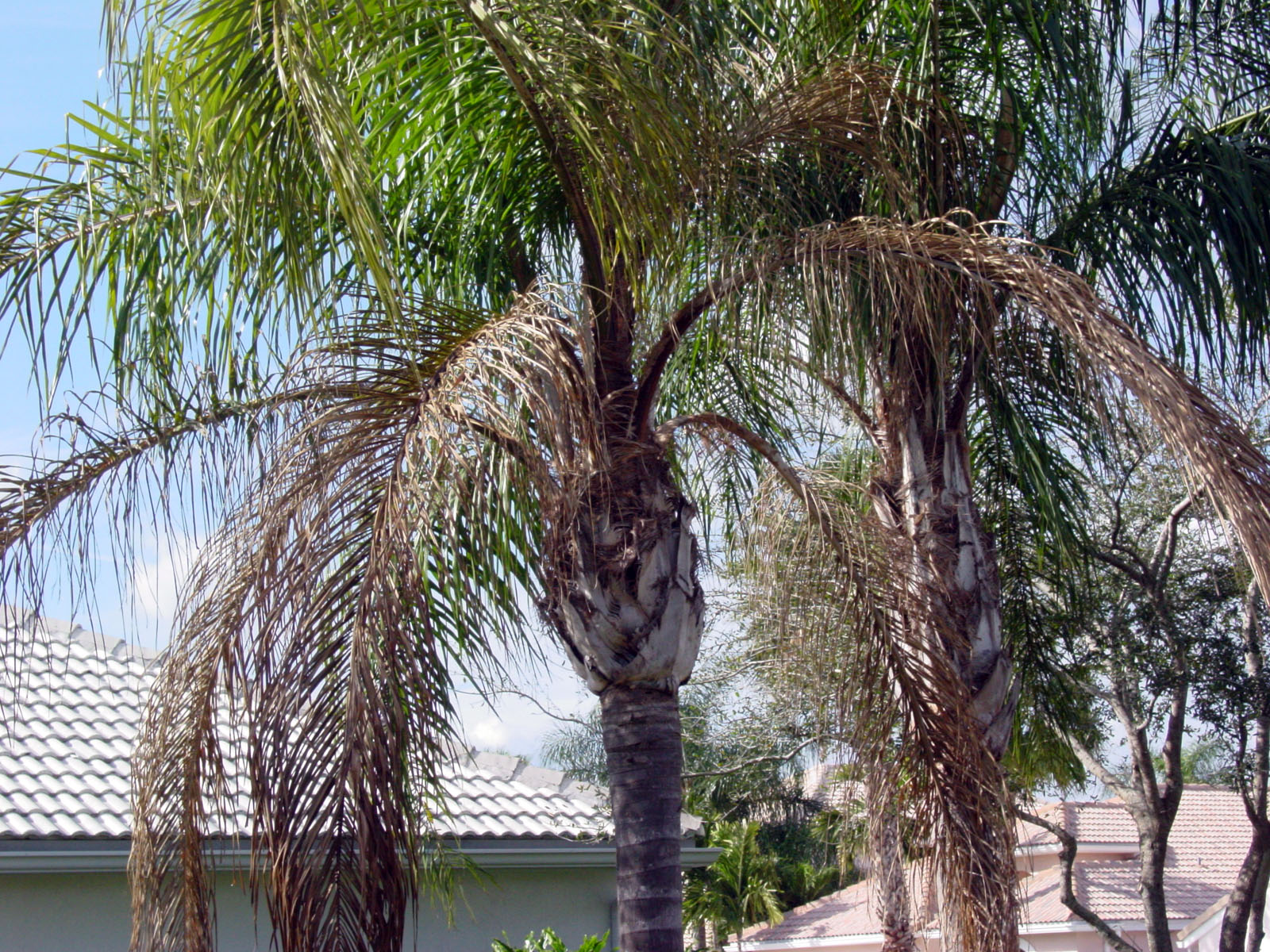 Symptoms of this fungal disease on queen palms begin on the oldest 2 to 3 fronds which turn brown but do not break or hang down. The next 2 to 3 younger fronds will turn varying shades of yellow and then brown. This will continue up the canopy until the entire palm canopy is brown. As the fronds are dying, there will be a brown stripe on the rachis (frond stem). Initially, there may also be one-sided death of the frond, with leaflets on one side of the frond turning brown while the leaflets on the other side are still green. The palm dies within a few months of infection.
Symptoms of this fungal disease on queen palms begin on the oldest 2 to 3 fronds which turn brown but do not break or hang down. The next 2 to 3 younger fronds will turn varying shades of yellow and then brown. This will continue up the canopy until the entire palm canopy is brown. As the fronds are dying, there will be a brown stripe on the rachis (frond stem). Initially, there may also be one-sided death of the frond, with leaflets on one side of the frond turning brown while the leaflets on the other side are still green. The palm dies within a few months of infection.  Symptoms on Mexican fan palms also follow this same general pattern. However, be aware that Mexican fan palms can get a petiole blight disease that is not normally fatal and is different from the Fusarium decline which is always fatal. Only a laboratory test can determine which disease is present.
Symptoms on Mexican fan palms also follow this same general pattern. However, be aware that Mexican fan palms can get a petiole blight disease that is not normally fatal and is different from the Fusarium decline which is always fatal. Only a laboratory test can determine which disease is present.Palms with Fusarium decline should be removed immediately and the canopy destroyed. There is no cure once a palm is infected, and no preventive fungicide treatment is recommended. The disease is probably spread by wind into new sites and could also be spread by contaminated pruning tools. Always make sure pruning tools are sterilized after each palm is trimmed or use a new saw blade.
All you can do at this point is to keep a sharp eye on your palms, stop trimming them so you can see early symptoms, and keep your fingers crossed that we don’t lose all of our palms to new and old diseases.
For more information contact the Extension Service Horticulture Helpline Tuesday, Wednesday or Thursday, 9 AM to noon and 1 to 4 PM, by calling 582-2110. Or visit the office M-F, 8 AM to 5 PM. You can see a narrated presentation about TPPD at: http://pinellascountyextension.org/ (select the commercial horticulture link). The presentation is located in a box on the right-hand side of the page that says ‘presentations’. You can also visit (Google) the Ft. Lauderdale Research and Education website and follow the links to palm diseases.
Information and pictures for this article were provided by Dr. Monica Elliott, Plant Pathologist, University of Florida/IFAS, Ft. Lauderdale Research and Education Center.
July 15, 2008
Helping our Children to Eat Better
 Obesity rates have risen sharply in the last twenty years. In Florida as many as one in five children are obese and just a few years ago it was estimated at one in ten. Obesity can lead to many health problems such as diabetes, heart disease, and high blood pressure.
Obesity rates have risen sharply in the last twenty years. In Florida as many as one in five children are obese and just a few years ago it was estimated at one in ten. Obesity can lead to many health problems such as diabetes, heart disease, and high blood pressure.In June of 2004 Congress passed a law reauthorizing federal funding for the Child Nutrition program. This program directs all school districts participating in the federally funded child nutrition programs to establish a local school wellness policy for all schools in their district. The link between nutrition, physical education, and academic achievement is strong. Poor nutrition and hunger interfere with cognitive function. Research has shown the school breakfast programs benefit students with improved ability to concentrate in the classroom and improvements in test scores.
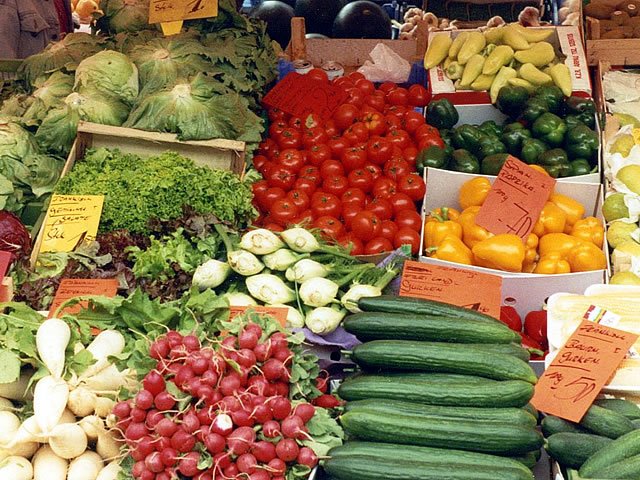 5 a day for Better Health is a national program and partnership that seeks to increase the number of daily servings. This program provides ideas for easy ways to add more fruits and vegetables to daily eating patterns. Be Wise about Your Portion Size is a statewide education campaign aimed at encouraging Floridians to be aware of portion sizes as well as their daily intake of food. This was started in 2005 in an effort to reduce the incidence of obesity in Florida.
5 a day for Better Health is a national program and partnership that seeks to increase the number of daily servings. This program provides ideas for easy ways to add more fruits and vegetables to daily eating patterns. Be Wise about Your Portion Size is a statewide education campaign aimed at encouraging Floridians to be aware of portion sizes as well as their daily intake of food. This was started in 2005 in an effort to reduce the incidence of obesity in Florida.Sample Recipes Youth Can Make:
Fruit Kabobs: On a long skewer, thread a grape, strawberry, marshmallow, cut kiwi, and strawberry. To keep the banana from turning brown, coat each piece with lemon juice before placing on the skewer. If strawberries are not in season, pineapple or other in season fruits can be used.
Homemade Granola Bars: Start with 3 ½ cups rolled oats (or oatmeal toasted on a cookie sheet for 15-20 minutes at 350○F, stirred occasionally.) Mix rolled oats, 1 cup nuts (chopped), 1 cup raisins, 2/3 cup butter or margarine, melted, ½ cup brown sugar, packed, ½ cup honey, corn syrup, or molasses, ½ teaspoon salt, and ½ teaspoon vanilla extract. When thoroughly mixed, press the mixture in a well greased 10 X 15 jelly roll pan and bake at 350 F for 12-15 minutes. Cool and a wire rack and cut into bars when cool.
A Few More Tips:
- For your summer picnics, radish roses or carrot curls are fun to make and eat. Remember to invite your children or teens to help. This will introduce them to different foods as you prepare the ingredients, and they are getting a second benefit of learning to eat healthier.
- As school gears up and you are thinking about lunches, let the children and teens shop with you and pick out ingredients for their lunches. With your guidance they can learn how to choose smart and stay healthy.
- While cooking (under supervision) youth are learning to read a recipe, measure ingredients properly (practices math skills), finish a project, and enjoy the results. All this will hopefully lead to better choices in food.
- Involve the children and teens in picking fresh produce as it becomes available - tomatoes in May and June or blueberries in May. The following is a link where you can find what fruit and vegetables is available for u-pick in Florida http://www.florida-agriculture.com/link_descriptions.htm . Many of the fruits and vegetables recommended for your 5-A-Day are available all winter long in Florida. In fact there are many Green Markets springing up in Pinellas County where you can purchase fresh produce all winter. One of these is sponsored by the Pinellas County Extension Service. For further information see the website: http://pinellas.ifas.ufl.edu/market/index.html
Resources:
Six Easy Bites – 4-H Foods Youth Activity Guide
http://www.doh.state.fl.us/Family/obesity/nutrition/index.html
http://nutrition.dadeschools.net/nutritioned.html
July 9, 2008
Strategies to Help You Save in the Supermarket
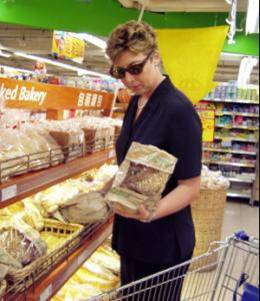 The rising energy costs, bad weather in the agricultural regions, and growing global demand for food are some of the factors that have caused the price of food to rise significantly over the past year. In the last several months alone, we have seen a double-digit increase in the cost of many of the products we buy in the supermarket.
The rising energy costs, bad weather in the agricultural regions, and growing global demand for food are some of the factors that have caused the price of food to rise significantly over the past year. In the last several months alone, we have seen a double-digit increase in the cost of many of the products we buy in the supermarket.To help you get the most for your money, try some of these simple cost saving strategies.
Make a list and stick to it
This can help you avoid some of the temptations that are lurking in the snack aisle, the candy aisle, and at the check out counter.
Buy produce in season
Check the food section in your newspaper to find the best buys for the week based on what is in season. Produce in season is usually priced to sell. In Florida, we are fortunate to have many types of produce available to us. Find out what’s in season http://pinellas.ifas.ufl.edu/sustainability/sustain_local_grown_food.shtml. Also, shop your local farmers' markets for great deals on local produce. There is a list of local markets on the Families and Consumers page on the website:
http://pinellas.ifas.ufl.edu/blog_timely_topics/Florida%20Community%20Farmers.pdf
Check out the sales
Plan meals around what is on sale. Use store circulars to help you find some good bargains. When buying staples, take advantage of the sales or the "buy one, get one free" deals.
Clip Coupons
The coupon insert in the Sunday paper can help you save money on things you normally buy. There are also some on-line websites like ValPak http://www.valpak.com/ and Smart Savings http://www.smartsavings.com/ that can help you save as well. Become familiar with their privacy policies though as you generally have to provide personal information.
Try canned, frozen or dried
Next time you are making that favorite recipe, try using frozen, canned, or dried foods. They may be less expensive compared to fresh, yet are equally nutritious. Produce is typically frozen, canned, or dried at the peak of ripeness, when nutrients are plentiful. Fish and poultry are often flash-frozen to minimize freezer damage and retain freshness. With frozen foods, you can use only the amount you need, reseal the package, and return it to the freezer. If it's properly stored, there's no waste. Rinse canned foods to get rid of extra sugar or salt. Dried fruits are concentrated in flavor and a great substitute for fresh fruit. Using powdered or evaporated versions of milk in soups, casseroles, mashed potatoes, or desserts can go a long way to stretch that food dollar. Buy the form that gives you the best price for your needs.
Buy less expensive protein foods
When possible, substitute inexpensive, sources of protein like beans, eggs, tofu, and legumes for more expensive meat, fish, or poultry. If you eat a meatless meal once a week you are more likely to increase your consumption of healthy plant foods while saving money. Try using a smaller portion of meat, fish, or poultry and extending the dish with whole grains, beans, and/or vegetables.
When you do buy meat, look for lean cuts
Lean cuts of beef are those that include the terms "loin" or "round." Buy a whole chicken and cut it up instead of paying the butcher to do it for you, or buy the less expensive "family pack" and portion it into airtight freezer bags.
Cut down on food waste
Think about how you are going to use the food you put in the cart, particularly perishable foods. Leftover vegetables, poultry, or meat can be a great addition to soups, stews, salads, and casseroles. If you have a roasted chicken for dinner on Monday night, you can turn into Chicken Divan for dinner on Wednesday night. Add a loaf of whole-grain bread and a salad to create a nutritious meal in minutes. Leftovers can make a great breakfast and lunch as well.
Bring your own
Instead of making a coffee stop on your way to work or going out to lunch, bring your own from home. Both of these strategies can add up to big savings. In addition, making lunch for you and your family is an excellent way to use leftovers and keep the ingredients healthy. Use freezer packs and containers to keep food at the proper temperature unless you have access to a refrigerator.
Consider store brands
Store brands are generally cheaper than the pricier national brands. Many grocery companies buy national-brand products made to their specifications and simply put their own label on the products. Ingredients are listed in order by weight so read the label to see if you are getting a good buy. Also look for simpler versions of your favorite foods. Buy plain oatmeal or simple cereals that contain fewer additives and are less expensive than fancier cereals.
Weigh the cost of convenience
In most cases, prepackaged foods can cost more. Also, the “100 calorie” snack packs are generally more expensive. Consider buying snack sized bags and make your own snack packs instead.
Buy and cook in bulk
Bulk purchases can be a great way to save money as long as they get used. Bulk warehouses like Sam’s and Costco can save you money but remember to take into account the annual membership fee. Cooking in bulk can save both money and time. Prepare food and freeze into “family-sized” portions. Portions will vary depending on the size of your family.
Check the entire shelf
Grocery stores will often place the higher priced items at eye-level, so look at the top and bottom of the shelf for potential better bargains
Pay attention
At checkout, watch scanners carefully. Some stores give you the item free if it is scanned wrong.
 Try out your green thumb
Try out your green thumbFor benefits that go beyond cost savings, plant your own fruits and vegetables. There's nothing better than fresh produce from the garden. University of Florida Extension has helpful gardening information to get you started http://edis.ifas.ufl.edu/TOPIC_Vegetable_Gardening.
July 8, 2008
Summer Backyard Pond Problems: Gasping Goldfish!
It’s a cool, misty morning, after one of our famous summer evening thunderstorms. You’ve gone out into the backyard to visit your ornamental pond and you see dead fish, possibly several, when just yesterday they seemed fine. Yikes, what happened? This is what the pond folks call summerkill.
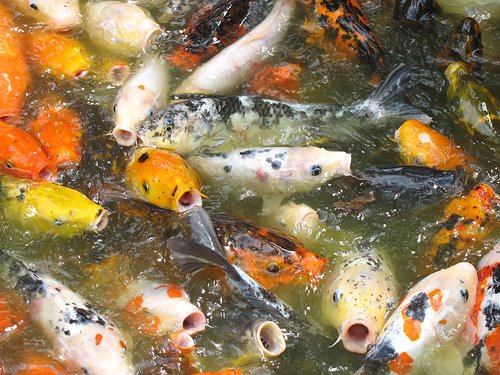 Summerkill is an oxygen depletion event. Most fish prefer an oxygen concentration in the water of about 4 parts per million (ppm), but sometimes, during the heat of late spring and early summer, a layer of oxygen poor water may form at the bottom of the pond. This bottom layer will be cooler, darker, and may smell bad. If the water on the bottom contains less than 2 ppm of dissolved oxygen the fish will try to stay out of it, even if they are a species that normally prefers cooler temperatures (i.e. goldfish, koi). Bacterial decomposition of organic material causes this "bad" water. In the decay process, bacteria consume dissolved oxygen in the water to aid in breaking down plant and animal material, further dropping oxygen levels.
Summerkill is an oxygen depletion event. Most fish prefer an oxygen concentration in the water of about 4 parts per million (ppm), but sometimes, during the heat of late spring and early summer, a layer of oxygen poor water may form at the bottom of the pond. This bottom layer will be cooler, darker, and may smell bad. If the water on the bottom contains less than 2 ppm of dissolved oxygen the fish will try to stay out of it, even if they are a species that normally prefers cooler temperatures (i.e. goldfish, koi). Bacterial decomposition of organic material causes this "bad" water. In the decay process, bacteria consume dissolved oxygen in the water to aid in breaking down plant and animal material, further dropping oxygen levels.Summerkill begins with overcast skies, hot weather and the return of rainy days. Low water levels, brought on by one of our normal, dry springs contribute to the problem. A heavy rain, flowing into the pond, can cause the top and bottom layers of the water to mix. After mixing, the pond may change color from its normal green to brown. This mixing may happen a day or two following the rain, and the subsequent drop in dissolved oxygen need only occur for a short time to kill fish. It might even happen during the night, so the oxygen concentration could be on its way back up toward normal levels by the time you wander out there.
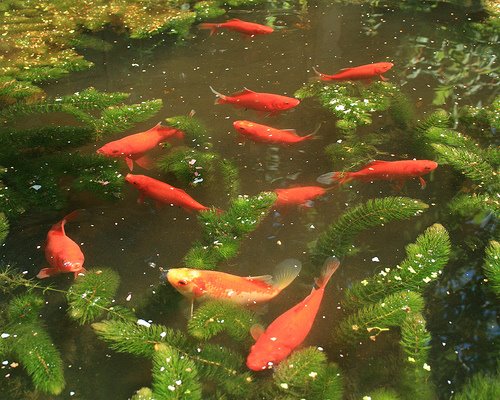 If you don’t have them already, adding live plants to the pond is helpful. Plants use sunlight to produce and add dissolved oxygen to the water, a process known as photosynthesis. When there are not enough plants, or when overcast skies keep sunlight from reaching the pond for several days, oxygen levels will drop. These plants can be anything from that suspended, microscopic algae that makes the water appear green, to broad-leafed aquatic plants, rooted in containers and submerged. Conversely, plants whose leaves float on the surface (i.e., water lilies) and other plants whose leaves are exposed to open air, do not contribute as much to the oxygen supply below the water surface.
If you don’t have them already, adding live plants to the pond is helpful. Plants use sunlight to produce and add dissolved oxygen to the water, a process known as photosynthesis. When there are not enough plants, or when overcast skies keep sunlight from reaching the pond for several days, oxygen levels will drop. These plants can be anything from that suspended, microscopic algae that makes the water appear green, to broad-leafed aquatic plants, rooted in containers and submerged. Conversely, plants whose leaves float on the surface (i.e., water lilies) and other plants whose leaves are exposed to open air, do not contribute as much to the oxygen supply below the water surface. Rain and wind from thunderstorms may also exacerbate the problems by stirring up bottom sediments, muddying the pond and further blocking the amount of sunlight penetrating the water. Rain can also wash in even more of the decaying organic material that our hungry bacteria in the bottom layer were decomposing to begin with.
You may experience oxygen depletion events for several nights running, until the pond stabilizes again. In this case it might be wise to add water or stir the surface each night until you are no longer greeted by gasping fish in the morning.
July 7, 2008
It’s Hurricane Season – Are your trees in shape?
As hurricane season arrives, there are many tree companies that are out and about offering to prune large trees and palms. Much of the pruning that is done can actually create a situation that puts the tree in more danger of failing in high winds than of providing protection. There has been a lot of research done at the University of Florida on the proper way to prune trees and the way that trees behave in high winds.
First, allow me to provide a bit of biology 101 refresher. The green leaves on trees and the green fronds on palms are the source of the food, through the process of photosynthesis, that these plants need to thrive and grow. When you remove green leaves and fronds, you reduce the ability of the plant to produce the food necessary to support the roots and top growth adequately. Fertilizer contains nutrients that are necessary for making proteins and enzymes but it is not the source of the food necessary to sustain the tree.
Reducing the amount of foliage on the ends of the branches, and thus the weight, is a better way to reduce risk of branch failure during high winds. The canopy can be opened up without removing all of the interior branches and attached foliage. An arborist certified by the International Society for Arboriculture is trained in the proper way to prune and protect trees. However, all certified arborists are not equal. When requesting a quote from an arborist, ask to see their certification card, proof of liability insurance (ask for this no matter who you hire), references, and also ask if they will be with their crew when the work is done. I would suggest three quotes and then maybe even go to look at some trees that they have pruned.
The following links lead to the extensive University of Florida information on tree pruning on the Internet:
Trees add considerably to the value of our property and keeping them healthy while providing protection from damage to our homes is a delicate balance that requires planning and caution. I hope that you will do your homework before allowing just anyone with a truck access to your trees.
July 2, 2008
Summertime and the Grillin’ is Easy
When it comes to grilling food, using the right barbeque sauce can make all the difference! While you can buy a number of different types of barbeque sauces at your local grocery store, you can also easily whip up a new sauce that will give your favorite grilled food a fresh kick. By switching up your barbeque sauces, you can instantly change a traditional meal into an exotic treat. Marinating your food before you cook will not only add more flavor, but it will also tenderize, or soften the food, which makes for a more succulent meal!
- Place the raw food in a bowl or a glass baking dish. Avoid using metal bowls when marinating, as the acidic marinades can react with the metal, making your food unsavory or unhealthy to eat.
- Season the food on both sides with salt and pepper.
- Pour the marinade over the food. If your food has a layer of fat or thick skin, peel back part of the fat or skin so that the marinade can reach the flesh more easily.
- Rotate the food in the marinade so that both sides are covered in the sauce.
- Cover and refrigerate the bowl or glass pan for half of the marinating time.
- Once half of the marinating time has passed, turn the food over so that the other side is submerged beneath the marinade.
- Cover and refrigerate for the remainder of the marinating time.
Once the marinating time is up, you can start cooking your flavored and tenderized food. Remember to toss out any remaining marinade and don't reuse it, as the contact with raw meats and fish has made it unsafe to eat
Source: http://www.barbeque.net/
Grilling Fruit
The great fruit-grilling movement is sweeping the country. Be adventurous and try your hand at grilling fruit as part of your cookout meal. Some grilling experts say that almost any fruit can be grilled, and they taste delicious. All we can suggest is that you try it!
Firm fruits like apples, pears, and pineapple are delicious and easy to grill. Softer fruits like mango, papaya, peaches, and nectarines require special attention since they cook quickly, and if overcooked, will reduce to a mush. These fruits need only to be heated and not "cooked." You might also like to try bananas, tangerines, and pineapples grilled in their skins. In general, leaving the skin or peel on the fruit helps it maintain its structural integrity as it cooks. Some people like to brush on olive oil. Softer fruits like peaches and nectarines might need to be put on foil that has several holes poked in it. Many fruits, including bananas, pineapples, peaches, plums, apples and pears can be cut in half, pitted or cored and then grilled. Oranges and other juicy fruits do best cut into thick slices. Have fun and experiment.
Place large pieces directly on the grill and smaller pieces on skewers or in a grill pan . To prevent their sticking to the grill, baste items very lightly with melted butter, a non-stick vegetable oil spray or an oil-based marinade.
There is any number of sauces that you can marinate the fruit in before grilling, brush on during grilling and/or serve with the fruit after grilling. Among the simplest may be a purée of the same fruits you’ve grilled, augmented with a little lemon juice and drizzled over the fruit after grilling. An even simpler approach is to bypass a sauce and sprinkle the fruit with brown sugar, cinnamon or ginger.
Grilling Vegetables
Go to your local farmer’s market and choose locally grown, sustainably raised fruits and vegetables. When you eat produce that has been picked only a day or two beforehand, you won’t need sauces or many flavorings.
Grilling vegetables couldn't be easier! All you have to do is brush on some extra virgin olive oil, sprinkle on salt and pepper to taste (if desired at all) and throw them on the grill. Vegetables don't need the same high heat that meat does, so it's best to cook them toward the sides of the grill where heat tends to be lower. Vegetables are best cooked over medium heat; fruits cook most evenly when cooked over low heat. Grilled asparagus is extremely popular. All you have to do is brush on olive oil, season to taste and put on the grill for 4 - 5 minutes in a grill basket that you’ve sprayed with oil. Portobello mushrooms are equally popular. Coat them also with extra virgin olive oil, season and simply throw on the grill. Cook for 6 to 10 minutes, turning once. But don't be shy - toss any vegetable on the grill to see how it tastes.
Shish Kabobs – The Portable Grilled Meal
The natural taste of shish kabobs is a perfect choice for guests or family meals. The versatile beauty of shish kabobs allows you to use any combination of meats, seafood, fruits and/or vegetables to please any palate. Just think of it; an entire meal on a stick! Kabobs can also be prepared in advance so you can enjoy spending more time with your guests.
Be creative and make fruit or vegetable shish kabobs with a variety of your favorite fresh produce. If you're making kabobs use rosemary branches instead of the common wooden bamboo skewers. Just strip the leaves from a rosemary branch and soak the branch in water for 30 minutes before threading the meat, veggies or fruit onto the branch. The wonderful rosemary flavor will be infused into the food as it is grilling!
Desserts Hot Off the Grill
Why not grill the whole meal? Grilled dessert recipes are fun and easy to make, but they also taste great and they’re healthy too! Here’s a great recipe from The American Institute for Cancer Research.
Grilled Fruit with Strawberry Dip
8 oz. part-skim ricotta cheese
2 Tbsp. plain non-fat yogurt
1/4 tsp. dried, ground ginger
8 strawberries, halved
4 peaches, halved or quartered
8 chunks pineapple
4 plums, nectarines, or papayas, halved
1/4 cup balsamic vinegar
2 tsp. granulated sugar
In a blender, purée cheese, strawberries, yogurt and ginger together until smooth. Refrigerate the dip for 2 hours before grilling fruit.
When ready to grill fruit, thread pieces of prepared fruit onto 8 skewers. Mix together vinegar and sugar. Grill fruit until lightly browned, turning frequently and brushing with vinegar mixture during grilling.
Serve grilled fruit with sauce on side.
Makes 8 servings. Per serving: 102 calories, 2 g. total fat (1 g. saturated fat), 18 g. carbohydrate, 4 g. protein, 2 g. dietary fiber, 40 mg. sodium.
References:
Barbeque Information and Facts
http://www.barbeque.net/
The American Institute for Cancer Research
http://www.aicr.org/
July 1, 2008
How Do I Know it’s Really Green?
In response to the desire of governments, businesses, non-profits, and society as a whole to live and be more socially, economically, and environmentally sustainable, there are a growing number of third party certification programs available. The following are non-profit nationally recognized third-party certification programs:
 GREENGUARD
GREENGUARDGREENGUARD certifies and identifies those products and materials that have low-emitting and non-toxic properties. The United States Environmental Protection Agency defines indoor environmental quality (IEQ) as ‘the quality of the air and environment inside buildings, based on pollutant concentrations and conditions that can affect the health, comfort and performance of occupants -- including temperature, relative humidity, light, sound and other factors.’ The release of chemicals into the atmosphere, such as volatile organic compounds (VOCs) can compromise indoor environmental quality. Research shows that most people spend 90% of their time indoors.
 Green Seal
Green SealGreen Seal collaborates with industry professionals to ensure responsible management and compliance in all aspects of the life cycle of a product such as the source of material extraction, manufacturing, operation, disposal, and reuse.
 Forest Stewardship Council (FSC)
Forest Stewardship Council (FSC) This international organization accredits third-party programs that certify environmentally responsible forest product management and production. As an accrediting organization this allows FSC to maintain an independent position between the third-party standards and the operations pursuing certification.
 Scientific Certifications Systems
Scientific Certifications SystemsSince 1984, this group offers certifications, audits, and testing for high level performance in environmental protection, social accountability, food safety and quality for both public and private entities.
Greener Choices – Consumer Reports Ecolabels
This program provides an interactive Web-based tool for consumers to research the green rating on appliances, cars, electronics, food and beverages, home and garden products. Eco-label.org was developed by Environmental Health Specialist, Urvashi Rangan, Ph.D.
Eco-labelling.org
This global Web-based resource contains 300 labels of recognized certifiers. This group provides in- depth information on each certifying program. This user-friendly tool allows the consumer to browse products and services by region and type.
Sustainable Forestry Initiatives (SFI)
This initiative utilizes a best management approach by training their loggers and developing outreach programs for the forestry landowners. SFI provides the following two types of label identification: 100% Certified Content Label which indicates that 100% of the raw material contained in the product has been certified by SFI or the Canadian Standard Association’s Standard (http://www.csa.ca/) and X% Certified Content Label which indicates that a percentage of the raw material contained in the product has been certified by the previously mentioned organizations.
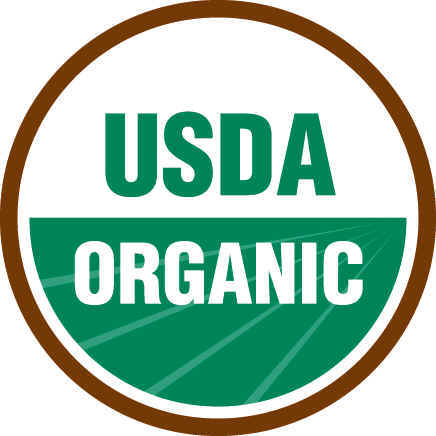 United States Department of Agriculture (USDA) Organic Label
United States Department of Agriculture (USDA) Organic LabelIn October 2002, the USDA National Organic Program developed a set of guidelines to certify the percentage of organic ingredients present in food. For single foods such as fruits and vegetables, look for the label on the food or on the signage in the area the food is stocked. For multi-ingredient foods such as snacks and beverages, look for the label on the packaging. In multi-ingredient foods the following classifications are used: 100% organic, organic (95-99% by weight), made with organic ingredients (70-94% by weight) and other (less than 70% by weight). Only the 100% - 95% will contain the USDA Organic Label.
Although this is just a sampling of the many independent programs, it gives you a brief look at the resources that are available to assist you with identifying the authenticity of an environmentally preferable, green or sustainable product. Purchasing products that carry the label from these organizations, will give the consumer the confidence that the product or service has been evaluated, tested, and researched to ensure that it was produced in the most environmentally responsible manner. Always remember that the manufacturer or vendor of a product should be able to produce documentation to verify that their product is truly green.
References
GREENGUARD (http://www.greenguard.org/Default.aspx?tabid=22)
Green Seal (http://www.greenseal.org/about/whatwedo.cfm)
Forest Stewardship Council (http://www.fsc.org/)
Scientific Certifications Systems (http://www.scscertified.com/)
Greener Choices – Consumer Reports Eco (www.greenerchoices.org/eco-labels)
Eco-labelling.org (http://www.ecolabelling.org/)
Sustainable Forestry Initiatives (http://www.sfi.org/)
Canadian Standard Association’s Standard (http://www.csa.ca/)
United States Department of Agriculture (USDA) Organic Label
What does the organic label really mean? www.ces.ncsu.edu/successfulfamily/Nutrition%20&%20Wellness/organlab.htm
USDA National Organic Program (http://www.ams.usda.gov/)
Thinking Green (May/June 2008) An Introduction to Third –Party Certification and Ecolabeling ASID ICON, Fluid Environments, Gainesville FL

